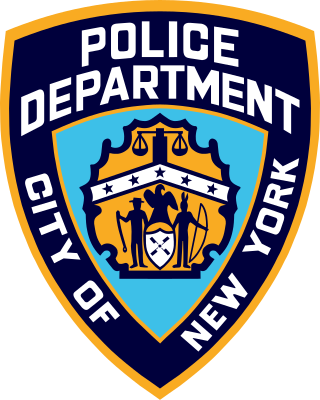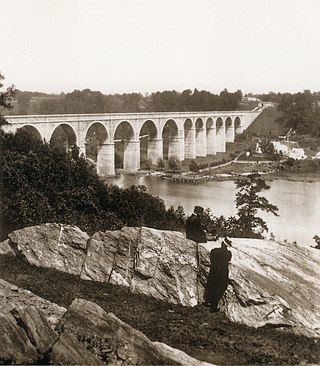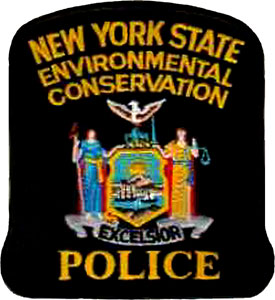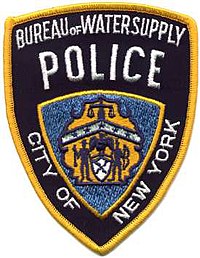
The New York City Transit Police Department was a law enforcement agency in New York City that existed from 1953 to 1995, and is currently part of the NYPD. The roots of this organization go back to 1936 when Mayor Fiorello H. La Guardia authorized the hiring of special patrolmen for the New York City Subway. These patrolmen eventually became officers of the Transit Police. In 1949, the department was officially divorced from the New York City Police Department, but was eventually fully re-integrated in 1995 as the Transit Bureau of the New York City Police Department by New York City Mayor Rudy Giuliani.

The New York City Police Department (NYPD), officially the City of New York Police Department, is the primary law enforcement agency within New York City. Established on May 23, 1845, the NYPD is the largest, and one of the oldest, municipal police departments in the United States.

The New York City Department of Parks and Recreation, also called the Parks Department or NYC Parks, is the department of the government of New York City responsible for maintaining the city's parks system, preserving and maintaining the ecological diversity of the city's natural areas, and furnishing recreational opportunities for city's residents and visitors.

The New York City Police Department Auxiliary Police is a volunteer reserve police force which is a subdivision of the Patrol Services Bureau of the New York City Police Department. Auxiliary Police Officers assist the NYPD with uniformed patrols, providing traffic control, crowd control, and other services during major events.

The Croton Aqueduct or Old Croton Aqueduct was a large and complex water distribution system constructed for New York City between 1837 and 1842. The great aqueducts, which were among the first in the United States, carried water by gravity 41 miles (66 km) from the Croton River in Westchester County to reservoirs in Manhattan. It was built because local water resources had become polluted and inadequate for the growing population of the city. Although the aqueduct was largely superseded by the New Croton Aqueduct, which was built in 1890, the Old Croton Aqueduct remained in service until 1955.

Rondout Reservoir is part of New York City's water supply network. It is located 75 miles (121 km) northwest of the city in the Catskill Mountains, near the southern end of Catskill Park, split between the towns of Wawarsing in Ulster County and Neversink in Sullivan County. It is the central collection point for the city's Delaware System, which provides half its daily consumption.

A combination of aqueducts, reservoirs, and tunnels supplies fresh water to New York City. With three major water systems stretching up to 125 miles (201 km) away from the city, its water supply system is one of the most extensive municipal water systems in the world.

The Port Authority of New York and New Jersey Police Department, or Port Authority Police Department (PAPD), is a law enforcement agency in New York and New Jersey, the duties of which are to protect and to enforce state and city laws at all the facilities, owned or operated by the Port Authority of New York and New Jersey (PANYNJ), the bi-state agency running airports, seaports, and many bridges and tunnels within the Port of New York and New Jersey. Additionally, the PAPD is responsible for other PANYNJ properties including three bus terminals, the World Trade Center in Lower Manhattan, and the PATH train system. The PAPD is the largest transit-related police force in the United States.

The Kensico Reservoir is a reservoir spanning the towns of Armonk and Valhalla, New York, located 3 miles (5 km) north of White Plains. It was formed by the original earth and gravel Kensico Dam constructed in 1885, which impounded waters from the Bronx and Byram rivers. In 1917, a new masonry dam was completed, replacing the old dam and expanding the water supply by bringing water from the Catskill Mountains over a distance of more than 100 miles.

The West Branch Reservoir is a reservoir in the New York City water supply system. Formed by impounding the upper reaches of the West Branch of the Croton River, it is located in the Putnam County, New York, towns of Kent, and Carmel, about 50 miles (80 km) north of New York City.

The New York City Department of Environmental Protection (DEP) is the department of the government of New York City that manages the city's water supply and works to reduce air, noise, and hazardous materials pollution.

The Hillview Reservoir is a 90-acre (0.36 km2) storage reservoir in southeastern Yonkers, New York. It was built within a six-year period from 1909–1915 by the New York City Board of Water Supply to receive water from the newly constructed Catskill Aqueduct, which drained water from the Ashokan Reservoir and sent it down into the Kensico Reservoir, where it would, in turn, be drained back into a continuation of the Catskill Aqueduct, and sent into the Hillview Reservoir. Frank E. Winsor was the engineer in charge of construction of both Hillview and Kensico as well as 32 miles (51 km) of the Catskill Aqueduct.
There are forty-five local police agencies in Westchester County, New York. As well as other agencies. They are responsible for protecting Westchester County, these agencies frequently work with one another in the surrounding counties. Current economic times has caused a few Westchester municipalities to consider consolidation of police services. The Westchester County Department of Public Safety started providing primary police services for the Town/Village of Mount Kisco in 2015.

The Florida Department of Environmental Protection (FDEP) is the Florida government agency responsible for environmental protection.

The New York State Department of Environmental Conservation Police, is the law enforcement agency of the New York State Department of Environmental Conservation, Division of Law Enforcement. NYS Environmental Conservation Officers are New York State police officers. As the uniformed law enforcement representatives of the Department of Environmental Conservation, environmental conservation police are responsible for the enforcement of the environmental laws and regulations of New York and for the detection and investigation of suspected violations.

The New York City Housing Authority Police Department was a law enforcement agency in New York City that existed from 1952 to 1995, which was then merged into the NYPD. The roots of this organization go back to 1934 and the creation of the New York City Housing Authority (NYCHA). New York City Mayor Fiorello H. La Guardia authorized the hiring of security guards to patrol the city's public housing buildings. These guards eventually were trained and became the first officers of the Housing Police, which was officially created in 1952. The Housing Police, along with the New York City Transit Police, was merged into the New York City Police Department in 1995 by New York City Mayor Rudy Giuliani and continues today as the Housing Bureau
Law enforcement in New York City is carried out by numerous federal, state, city and private agencies. New York City has the highest concentration of law enforcement in the United States.

[[File:Crotonrivermap.png|thumb|right|Map of the Croton River watershed. Note that this is not identical with the New York City water supply system's "Croton Watershed"{{efn|Numerous small natural lakes and ponds, as well as large Lake Mahopac, are part of the Croton River's watershed but not part of New York City’s supply system. A map of the actual Croton Watershed is found here. ]]
Vincent Sapienza is an American civil servant who is serving as the Chief Operating Officer of the New York City Department of Environmental Protection. From 2017 to 2022, he was the agency's Commissioner.























